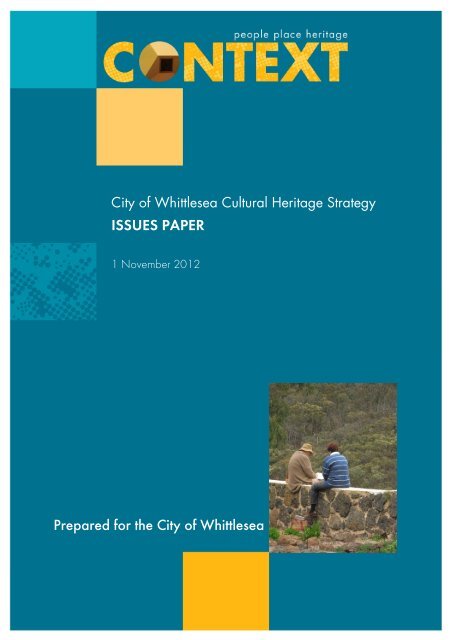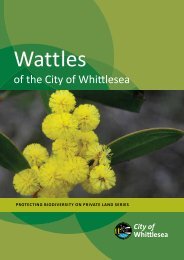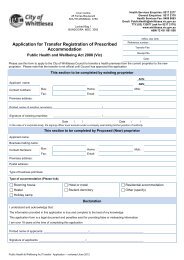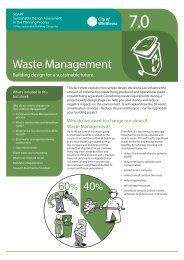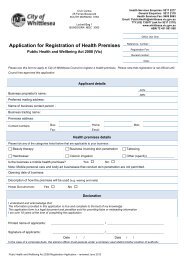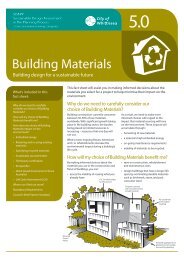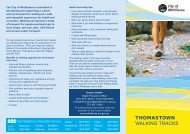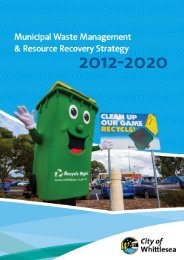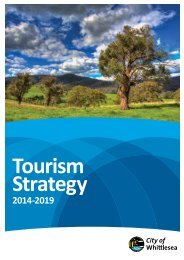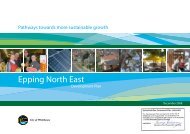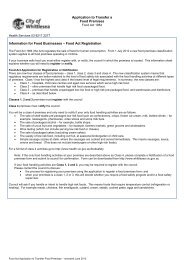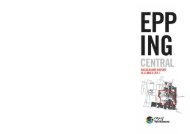Cultural Heritage Study Issues Paper - City of Whittlesea
Cultural Heritage Study Issues Paper - City of Whittlesea
Cultural Heritage Study Issues Paper - City of Whittlesea
Create successful ePaper yourself
Turn your PDF publications into a flip-book with our unique Google optimized e-Paper software.
<strong>City</strong> <strong>of</strong> <strong>Whittlesea</strong> <strong>Cultural</strong> <strong>Heritage</strong> Strategy<br />
ISSUES PAPER<br />
1 November 2012<br />
Prepared for the <strong>City</strong> <strong>of</strong> <strong>Whittlesea</strong>
ii<br />
© Context Pty Ltd 2012<br />
Project Team:<br />
Louise Honman<br />
Chris Johnston<br />
Report Report Register<br />
Register<br />
This report register documents the development and issue <strong>of</strong> the report entitled <strong>Whittlesea</strong><br />
<strong>Cultural</strong> <strong>Heritage</strong> Strategy Draft <strong>Issues</strong> <strong>Paper</strong> undertaken by Context Pty Ltd in accordance with<br />
our internal quality management system.<br />
Project<br />
No.<br />
Issue<br />
No.<br />
Notes/description Issue<br />
Date<br />
Issued to<br />
1600 1 Draft issues paper 20/8/2012 Katelyn Stanyer, Sarah<br />
Finlay and Project<br />
Management Group<br />
1600 2 Final issues paper 5/9/2012 Sarah Finlay<br />
1600 3 <strong>Issues</strong> paper (for circulation) 1/11/2012 Sarah Finlay<br />
Context Context Pty Pty Ltd<br />
Ltd<br />
22 Merri Street, Brunswick 3056<br />
Phone 03 9380 6933<br />
Facsimile 03 9380 4066<br />
Email context@contextpl.com.au<br />
Web www.contextpl.com.au
CONTENT S<br />
INTRODUCTION 1<br />
Our purpose 1<br />
<strong>City</strong> <strong>of</strong> <strong>Whittlesea</strong> 1<br />
Shaping the Strategy 1<br />
Method 2<br />
Shaping a vision 2<br />
Principles 3<br />
Goals/objectives 4<br />
1 Knowing our heritage 4<br />
2 Protecting and managing our heritage 6<br />
3 Supporting and enabling our heritage 9<br />
4 Communicating and promoting our heritage 11<br />
SUMMARY 13<br />
OTHER ISSUES 13<br />
RESOURCES 14<br />
Sources used 14<br />
Background references 14<br />
iii
CULTURAL HERITAGE STRATEGY<br />
iv
INTRODUCTION<br />
ISSUES PAPER<br />
Our purpose<br />
The <strong>City</strong> <strong>of</strong> <strong>Whittlesea</strong> is preparing its first <strong>Cultural</strong> <strong>Heritage</strong> Strategy. This strategy will be<br />
developed from a combination <strong>of</strong> research and consultation and articulate Council’s<br />
commitment to cultural heritage by developing a strategic vision, identifying goals and<br />
objectives, and developing strategies and actions. The <strong>Cultural</strong> <strong>Heritage</strong> Strategy will integrate<br />
with other Council strategies.<br />
The <strong>City</strong> <strong>of</strong> <strong>Whittlesea</strong> has engaged consultants (Context Pty Ltd) to assist in the preparation<br />
<strong>of</strong> the Strategy. This issues paper has been prepared following the first round <strong>of</strong> consultation<br />
and the literature review. Its purpose is to assemble information gathered this far and to put<br />
forward questions that will be discussed in the second round <strong>of</strong> consultation.<br />
The <strong>Cultural</strong> <strong>Heritage</strong> Strategy will build on the achievements already made, and look to the<br />
future to imagine what might be required to meet the needs <strong>of</strong> <strong>Whittlesea</strong> in conserving its<br />
unique cultural heritage for current and future generations.<br />
You You are are invited invited to to respond respond respond to to this issues paper by attending attending attending the the <strong>Whittlesea</strong> <strong>Whittlesea</strong> <strong>Cultural</strong><br />
<strong>Cultural</strong><br />
<strong>Heritage</strong> <strong>Heritage</strong> Strategy Strategy Community Community Community Workshop Workshop on on Thursday Thursday 22 22 November November 2012, 2012, 11-3pm,<br />
1 3pm,<br />
calling calling 9217 9217 9217 2165 2165 or or emailing emailing emailing heritagestrategy@whittlesea.vic.gov<br />
heritagestrategy@whittlesea.vic.gov.au<br />
heritagestrategy@whittlesea.vic.gov .au .au<br />
<strong>City</strong> <strong>of</strong> <strong>Whittlesea</strong><br />
A snapshot <strong>of</strong> the <strong>City</strong> <strong>of</strong> <strong>Whittlesea</strong> shows that the geography, Aboriginal occupation,<br />
settlement patterns and migration have shaped the area. The Wurundjeri wilam people have a<br />
strong connection to the land that they travelled in search <strong>of</strong> resources, fresh water, food and<br />
shelter; the Plenty River and many creeks <strong>of</strong>fering various types <strong>of</strong> fish and birdlife. They held<br />
cultural ceremonies and conducted business and trade negotiations at sacred sites. Over 700 <strong>of</strong><br />
these sites still exist in the <strong>City</strong> today, as well as many sacred ‘scarred’ trees.<br />
Approximately 50% <strong>of</strong> the population is Australian born and the other 50% come from a<br />
diverse range <strong>of</strong> cultural backgrounds. Major countries <strong>of</strong> birth are Italy, Greece, Macedonia,<br />
Viet Nam, Malta, Lebanon, India, New Zealand, Sri Lanka and the Philippines. These<br />
residents have brought aspects <strong>of</strong> their own cultural heritage to the city over many years, which<br />
contributes greatly to the character and identity <strong>of</strong> the <strong>City</strong> <strong>of</strong> <strong>Whittlesea</strong>.<br />
The area features a wide range <strong>of</strong> landforms including the Western Basalt Plains, the Plenty<br />
Valley and the Plenty Ranges. In the north the slopes and valleys <strong>of</strong> the Great Dividing Range<br />
support both cleared agricultural land and forested areas like Kinglake National Park. These<br />
areas have high habitat value and are part <strong>of</strong> the Yan Yean, Merri Creek and Plenty River<br />
catchments.<br />
The <strong>City</strong> <strong>of</strong> <strong>Whittlesea</strong> is also an area <strong>of</strong> high ecological diversity. To the west, the basalt plains<br />
area features highly significant grasslands. There are also many river red gums between 200 and<br />
500 years old in the area.<br />
As a growth municipality, <strong>Whittlesea</strong> is undergoing rapid change and development. Significant<br />
sites and histories are being impacted and in some instances disappearing. The urban<br />
development <strong>of</strong> the city is transforming the rural landscape.<br />
Shaping the Strategy<br />
This issues paper contains the following components:<br />
Vision Vision : a draft <strong>of</strong> some ideas that encompass a statement <strong>of</strong> significance for <strong>Whittlesea</strong>’s<br />
heritage and the roles <strong>of</strong> Council and the community in achieving the vision<br />
1
CULTURAL HERITAGE STRATEGY<br />
2<br />
Principles Principles: Principles the underpinning values<br />
Goals Goals or or objectives objectives: objectives objectives what needs to be achieved and the desired outcomes under ‘challenges’<br />
for each goal.<br />
Strategies Strategies: Strategies how the goals/objectives will be achieved- these are noted in draft form in ‘shaping<br />
the strategies’ for each goal.<br />
An action plan will also be prepared as part <strong>of</strong> the Strategy. The action plan would include :<br />
• Programs and initiatives<br />
• Who is responsible for delivery<br />
• Resources needed<br />
• Monitoring and review<br />
Method<br />
The workshops asked the following questions <strong>of</strong> participants.<br />
• How are we going with heritage now?<br />
• What is going well, and not so well?<br />
• What could a <strong>Cultural</strong> <strong>Heritage</strong> Strategy deliver for our communities?<br />
• What are some <strong>of</strong> the expectations <strong>of</strong> Council?<br />
• What roles should Council play in cultural heritage?<br />
Discussion was structured around four goals or ‘themes’ based on the <strong>Heritage</strong> Victoria<br />
Information Guide Local Government <strong>Heritage</strong> Strategies.<br />
• Knowing: identifying, assessing and documenting heritage places.<br />
• Protecting & Managing: securing statutory protection for significant places, developing<br />
policies and guidelines to assist decision making, appropriate management for Councilowned<br />
heritage places and assets.<br />
• Supporting: that is, providing the support needed by heritage place owners and managers<br />
for example, incentives, advisory services, financial assistance.<br />
• Communicating and promoting: actions to raise awareness and appreciation <strong>of</strong> the heritage<br />
<strong>of</strong> the area.<br />
This issues paper provides a summary <strong>of</strong> the following under each goal:<br />
• Findings and analysis <strong>of</strong> the literature search incorporated into each <strong>of</strong> the four strategic<br />
directions.<br />
• A summary <strong>of</strong> the content <strong>of</strong> the first consultation sessions with Council <strong>of</strong>ficers and<br />
representatives <strong>of</strong> a range <strong>of</strong> community groups.<br />
• Starting to shape the vision, principles, goals and strategies from that material.<br />
Shaping a vision<br />
Shaping a vision for cultural heritage may include the following:<br />
For discussion<br />
• A statement <strong>of</strong> significance for <strong>Whittlesea</strong> should give a broad interpretation <strong>of</strong> what<br />
heritage is, and include Aboriginal, natural and cultural heritage both tangible and<br />
intangible for past present and future generations.
ISSUES PAPER<br />
• <strong>Heritage</strong> is a shared responsibility between Council, referral authorities and the community,<br />
with roles for each. These roles may include Responsible Authority, provider, enabler,<br />
supporter or simply participant.<br />
• That the broad view <strong>of</strong> heritage is best supported by a ‘whole <strong>of</strong> Council’ approach that<br />
brings different perspectives to cultural heritage, including planning, arts and culture,<br />
recreation, tourism and economic development.<br />
Principles<br />
The principles or values that underpin the vision may include:<br />
• That cultural heritage is diverse, contemporary, living, inter-woven and changing.<br />
• That cultural heritage may assist in engendering a pride <strong>of</strong> place for both established and<br />
emerging communities.<br />
• That understanding the many connections to place as documented, acknowledged or<br />
expressed is fundamental to people’s identity and sense <strong>of</strong> belonging.<br />
Learning about river red gums in <strong>Whittlesea</strong>. Source <strong>City</strong> <strong>of</strong> <strong>Whittlesea</strong><br />
3
CULTURAL HERITAGE STRATEGY<br />
4<br />
Goals/objectives<br />
This section orders the material from the background review and the first consultation session.<br />
It includes achievements, challenges and shaping the strategies under each goal.<br />
1 Knowing our heritage<br />
This This goal goal is is about about improving improving and and extending extending what what we we know know about about the the cultural cultural heritage heritage <strong>of</strong><br />
<strong>of</strong><br />
<strong>Whittlesea</strong>. <strong>Whittlesea</strong>.<br />
<strong>Whittlesea</strong>.<br />
Achievements<br />
Council strongly acknowledges the importance <strong>of</strong> Aboriginal, natural and cultural heritage in<br />
<strong>Whittlesea</strong>, and the role that heritage plays in the formation <strong>of</strong> identity and a sense <strong>of</strong> place.<br />
This is reflected in the strategies and plans already completed across a diverse range <strong>of</strong> areas <strong>of</strong><br />
Council activity.<br />
• Council has strategies on a broad range <strong>of</strong> topics that embrace some aspects <strong>of</strong> heritage<br />
including Local and Family History, <strong>Cultural</strong> Collections, River Red Gums, Green Wedge,<br />
Environment, an Integrated <strong>Cultural</strong> Plan and a Strategic Community Plan.<br />
• A thematic history and heritage studies <strong>of</strong> both the Indigenous and European settlement<br />
have been completed encompassing broad geographic areas and some precincts or small<br />
sites. Approximately seven hundred places are recorded on the Aboriginal Affairs Victoria<br />
database, including over five hundred artefact scatters, 135 scarred trees, 19 earth features,<br />
12 object collections, three quarries, and one burial and shell deposit identified and<br />
recorded.<br />
• The heritage schedule for <strong>Whittlesea</strong> lists 88 places on the <strong>Heritage</strong> Overlay and <strong>of</strong> those<br />
there are 14 places on the Victorian <strong>Heritage</strong> register. There are 200 post-contact<br />
archaeological places recorded on the Victorian <strong>Heritage</strong> Inventory.<br />
• There are recommendations for another 94 places to be added to the <strong>Heritage</strong> Overlay as a<br />
result <strong>of</strong> the 2009 heritage study, and an additional 15 sites as a result <strong>of</strong> the 2010 historical<br />
archaeological study. 1<br />
• The area has a large number <strong>of</strong> studies <strong>of</strong> Aboriginal sites and these are listed in the<br />
references. <strong>Cultural</strong> <strong>Heritage</strong> Management Plans (CHMPs)are prepared prior to changes in<br />
the rural landscape.<br />
• Natural heritage: <strong>of</strong> the 350 native plant species, 20 are recognised as having state<br />
significance. River Red Gums are a particularly important part <strong>of</strong> the landscape, have<br />
heritage value and provide habitat and food for native fauna. Sites <strong>of</strong> national flora and<br />
fauna significance include Craigieburn Grasslands, Bald Hill Grasslands and Hernes<br />
Swamp. 2<br />
• There is a lot <strong>of</strong> heritage information on existing Council GIS layers, the asset database and<br />
the databases <strong>of</strong> other agencies such as Aboriginal Affairs, <strong>Heritage</strong> Victoria etc. but this is<br />
not always accessible by people who need to use it.<br />
• Both Council and the community are keen to work with new and emerging technologies in<br />
order to capture and record knowledge, for example at Farm Vigano stories (oral history) is<br />
being recorded on digital technology.<br />
1 Context Pty Ltd, 2010 <strong>Whittlesea</strong> Historical Archaeology <strong>Study</strong> and Context Pty Ltd, 2009<br />
<strong>Whittlesea</strong> <strong>Heritage</strong> <strong>Study</strong>.<br />
2 <strong>City</strong> <strong>of</strong> <strong>Whittlesea</strong>, Draft Environmental Sustainability Strategy, 2012-2022
ISSUES PAPER<br />
• The <strong>Cultural</strong> <strong>Heritage</strong> Program, in its thirteenth year <strong>of</strong> operation has become a vehicle for<br />
sharing knowledge about tangible and intangible heritage, including stories, music, food,<br />
language etc.<br />
• The <strong>City</strong>’s <strong>Cultural</strong> Collection is a significant asset, in particular the photograph collection<br />
is an important resource in documenting places at a point in time and in recording changes<br />
to those places.<br />
• In summary there is good knowledge about some aspects <strong>of</strong> heritage but there are also<br />
significant gaps in the knowledge base. Gaps include key aspects <strong>of</strong> <strong>Whittlesea</strong>’s history<br />
such as post war migration history and places, or about history largely hidden from view<br />
such as that <strong>of</strong> Janefield Colony and Training Centre.<br />
Challenges<br />
The challenges for Council and the community in extending and improving the knowledge<br />
base are about accessibility, responding to new knowledge and emerging ways for recording<br />
knowledge.<br />
• <strong>Heritage</strong> information already in Council’s own and other databases may <strong>of</strong>ten be in a form<br />
that is not easy to use or share. People who may have a direct interest or need for that<br />
knowledge may be unaware <strong>of</strong> its existence.<br />
• The community <strong>of</strong>ten does not know what historical research is being done, by whom and<br />
where it might be accessed. Local libraries do have some local history resources but there is<br />
little co-ordination <strong>of</strong> their collections and activities.<br />
• A challenge for Council and the community is in understanding the scope and use <strong>of</strong> new<br />
technologies for capturing and recording knowledge, including using existing Council<br />
databases in a more integrated manner.<br />
• Outside agencies may not necessarily share information with Council resulting in a lack <strong>of</strong><br />
co-ordination about activities that may impact on each other. An example is the carrying<br />
out <strong>of</strong> prescribed burning and cultural heritage surveys, both <strong>of</strong> which are programmed and<br />
implemented by different agencies.<br />
• There is no recognised process within Council to record new heritage knowledge as it<br />
comes to light, nor for the responsible <strong>of</strong>ficers to respond to and use that knowledge.<br />
• Aboriginal and post-contact heritage is connected in many and various ways. Documenting<br />
knowledge within a more seamless and integrated framework is a challenge.<br />
• Addressing knowledge gaps where they occur and when so that Council can respond to<br />
issues in a timely manner.<br />
Shaping the strategies<br />
For discussion<br />
The emerging strategies under the theme <strong>of</strong> improving and extending heritage knowledge may<br />
include:<br />
• How can existing heritage knowledge be better integrated to provide easier access for<br />
Council <strong>of</strong>ficers and the community?<br />
• How might Council respond to new and emerging methods for capturing and recording<br />
heritage knowledge?.<br />
• How might Council build relationships with other agencies to improve and co-ordinate<br />
activities that require the use <strong>of</strong> heritage knowledge?<br />
• How might Council be involved in the co-ordination <strong>of</strong> heritage knowledge from other<br />
groups. For example, what is Council’s role in Aboriginal heritage and culture?<br />
5
CULTURAL HERITAGE STRATEGY<br />
6<br />
2 Protecting and managing our heritage<br />
This This goal goal is is about about managing managing <strong>Whittlesea</strong>’s <strong>Whittlesea</strong>’s cultural cultural heritage heritage responsibly responsibly for for past, past, present<br />
present<br />
and and future future future generations. generations.<br />
generations.<br />
Achievements<br />
The <strong>City</strong> <strong>of</strong> <strong>Whittlesea</strong> plays a major role in the protection and management <strong>of</strong> heritage places<br />
using the Planning and Environment Act (1987) and the Victorian Planning Provisions to<br />
protect historic and Aboriginal places, environmental and landscape values. The primary tools<br />
<strong>of</strong> protection in the Planning Scheme are the <strong>Heritage</strong> Overlay, Significant Landscape Overlay<br />
or Vegetation Protection Overlay. A review <strong>of</strong> the <strong>City</strong> <strong>of</strong> <strong>Whittlesea</strong> Planning Scheme is an<br />
on-going process and a strengthening <strong>of</strong> the heritage policy is expected as part <strong>of</strong> that review.<br />
The <strong>Heritage</strong> Overlay is effective for buildings, gardens and trees and for objects associated<br />
with places. It is a less effective instrument for protecting collections not necessarily attached<br />
to a particular place. Archaeological sites are automatically protected if over 50 years old, or on<br />
the Victorian <strong>Heritage</strong> Inventory. <strong>Heritage</strong> places <strong>of</strong> state significance are protected under the<br />
Victorian <strong>Heritage</strong> Act (1995) Aboriginal sites are protected under the Aboriginal <strong>Heritage</strong> Act<br />
(2006).<br />
The draft Environmental Sustainability Strategy has urban development and the built<br />
environment as one <strong>of</strong> its priority areas. Sustainability and heritage can work together in ideas<br />
about identity distinctiveness, community and participation. The direction proposed for the<br />
established areas <strong>of</strong> Bundoora, Epping, Mill Park, Thomastown and Lalor is that <strong>of</strong> urban infill<br />
to maximize access to already established facilities.<br />
• The Melbourne Water <strong>Cultural</strong> <strong>Heritage</strong> Strategy covers the parts <strong>of</strong> the Yan Yean and<br />
Maroondah systems within <strong>Whittlesea</strong> and provides a good overview <strong>of</strong> the management <strong>of</strong><br />
cultural heritage assets, both Indigenous and non-Indigenous.<br />
• A Green Wedge Management Plan supports a variety <strong>of</strong> places and activities including<br />
farming, heritage places, scenic landscapes, and parks, as well as settlements supporting rural<br />
living.<br />
• Opportunities arise and are acted on, negotiating for the protection <strong>of</strong> heritage assets even<br />
when these are not on the <strong>Heritage</strong> Overlay. This can be effective and result in the<br />
conservation <strong>of</strong> a heritage place but is time consuming and <strong>of</strong>ten reactive.<br />
• Other planning tools are used such as the Development Plan Overlay to seek protection <strong>of</strong><br />
specific items in areas <strong>of</strong> change, for example the protection <strong>of</strong> river red gums and the Peter<br />
Lalor Home Building Co-operative precinct.<br />
• Some places are very well managed, conserving and interpreting their heritage values, for<br />
example Westgarthtown and Farm Vigano. These places <strong>of</strong>ten rely on a partnership with<br />
Council in the form <strong>of</strong> a ‘Friends’ group and volunteers.<br />
• Places <strong>of</strong> primarily natural value are protected by the Department <strong>of</strong> Sustainability and<br />
Environment, and managed through their agency Parks Victoria. These places <strong>of</strong>ten<br />
contain layered values <strong>of</strong> cultural, natural and Aboriginal heritage. In <strong>Whittlesea</strong> parks<br />
include Plenty Gorge Parklands, Merri Creek Parklands, Craigieburn Grassland Nature<br />
Conservation Reserve, Yan Yean Reservoir Park, Kinglake National Park and Toorourrong<br />
Reservoir Park.<br />
Collections<br />
Collections<br />
• The <strong>City</strong> <strong>of</strong> <strong>Whittlesea</strong> owns and manages a <strong>Cultural</strong> Collection and is guided by the<br />
<strong>Cultural</strong> Collections Strategy (2008-2012). The <strong>Cultural</strong> Collection is made up <strong>of</strong> three<br />
distinct collections, visual art, public art and civic history. The strategy makes<br />
recommendations for the acquisition, conservation, interpretation and display <strong>of</strong> items in<br />
the collection and is a comprehensive document promoting best practice in management.
ISSUES PAPER<br />
• The <strong>Cultural</strong> Collection complements other collections the Yarra Plenty Regional Library<br />
(YPRL) History Collection and the <strong>Whittlesea</strong> Historical Society Inc. Collection. The<br />
<strong>Cultural</strong> Collections Strategy includes the recommendation for Council to develop a single<br />
electronic catalogue for all three history collections in the municipality.<br />
Challenges<br />
There are many challenges for <strong>Whittlesea</strong> in the protection and management <strong>of</strong> heritage places,<br />
collections and intangible heritage, and these are <strong>of</strong>ten as a result <strong>of</strong> the rapidly shifting ruralurban<br />
interface, differences between emerging and settled areas and the rapid pace <strong>of</strong> change <strong>of</strong><br />
the environment and communities.<br />
• Many heritage places have been documented but appropriate resourcing to implement<br />
changes to the Planning Scheme in order to protect them has been a challenge.<br />
• Despite the regulations for the protection <strong>of</strong> Aboriginal places, these are still being<br />
destroyed as land is developed.<br />
• The rapid rate <strong>of</strong> change <strong>of</strong> the rural environment puts pressure on many activities <strong>of</strong><br />
Council, including heritage protection and management and finding ways to respond in a<br />
timely manner is difficult.<br />
• Some <strong>of</strong> the processes for protection and management by other agencies are seen as remote<br />
from Council, and do not involve the community in their implementation.<br />
• Negotiated outcomes with developers are <strong>of</strong>ten not as effective as they might be as heritage<br />
assets are rarely complete, and <strong>of</strong>ten require substantial work and expenditure to properly<br />
conserve them, find new uses etc. Places may be retained but <strong>of</strong>ten there is no immediate<br />
use in mind, or means <strong>of</strong> funding essential conservation works.<br />
• There is little capacity within Council to enforce the provisions <strong>of</strong> the Planning and<br />
Environment Act when someone ‘does the wrong thing’, and any breaches form a less than<br />
desirable precedent.<br />
• There is a (correct) perception within the community that <strong>Heritage</strong> Overlays do not solve<br />
all problems, and there is still more to do to effectively manage a place. Management plans<br />
are rarely done as the resourcing to complete these for all Council-owned heritage places is<br />
limited.<br />
• Funds for resourcing heritage are <strong>of</strong>ten in the form <strong>of</strong> short term projects (12 months or<br />
less) with little commitment to programs over a longer time frame. Grant applications take<br />
time and effort to co-ordinate and prepare.<br />
• Not all place types may be protected equally, for example dry-stone walls, some nonindigenous<br />
vegetation such as nineteenth century hawthorn hedges.<br />
• <strong>Heritage</strong> planning can sometimes be controversial and even divisive, leading to some<br />
negative perceptions or misunderstandings amongst the community. There has <strong>of</strong>ten been<br />
minimal resourcing <strong>of</strong> public education when implementation does occur, for example the<br />
Peter Lalor Estate planning amendment has caused some anxiety in the community<br />
affected.<br />
• For the community there is a strong perception that ‘heritage places are good spaces’ but<br />
there is some fatigue about constantly having to fight heritage battles to protect these places.<br />
• Protective measures such as <strong>Heritage</strong> Overlays or Development Plan Overlays need<br />
evaluation to see if they are effective in conserving heritage places, for example there is the<br />
perception that the area <strong>of</strong> a Vegetation Protection or Development Plan Overlay may not<br />
be large enough in area to protect river red gums.<br />
• The transfer <strong>of</strong> heritage places to Council or community ownership as part <strong>of</strong> land<br />
subdivisions may not be planned in advance, creating a situation where use and<br />
7
CULTURAL HERITAGE STRATEGY<br />
8<br />
management is not always well considered. This is <strong>of</strong>ten the solution <strong>of</strong>fered by developers<br />
and Council are forced to make decisions under pressure. The heritage implications may<br />
<strong>of</strong>ten be known in advance but not necessarily planned for.<br />
Shaping the strategies<br />
For discussion<br />
The emerging strategies under the theme <strong>of</strong> protection and management <strong>of</strong> heritage places<br />
could include:<br />
• How might Council establish longer term (three year plus) programs to protect places<br />
already assessed?<br />
• How might the focus <strong>of</strong> heritage activities shift to include more management <strong>of</strong> heritage<br />
places as well as protecting them?<br />
• How can the financial and other responsibilities for heritage management <strong>of</strong> places be<br />
shared with others, including developers?<br />
• How might Council meet the challenges <strong>of</strong> change and sustainability as part <strong>of</strong> protecting<br />
and managing heritage places and giving them an on-going life?<br />
• What public information and education on heritage planning is required to minimize<br />
conflict in the community over the protection <strong>of</strong> heritage places?<br />
• What might be process for identifying ‘at risk’ aspects <strong>of</strong> Aboriginal, natural or cultural<br />
heritage and having a ‘quick response’ to their protection and management?<br />
Enjoying Wallaby Creek Weir. Source: <strong>City</strong> <strong>of</strong> <strong>Whittlesea</strong>
ISSUES PAPER<br />
3 Supporting and enabling our heritage<br />
This This goal goal is is about about supporting heritage programs and strengthening strengthening existing existing links between between<br />
Council, Council, heritage heritage groups groups and and the the community.<br />
community.<br />
Achievements<br />
People’s connections to local places are an important contributor to community identity, and<br />
their views contribute to the investigation <strong>of</strong> significance. <strong>Whittlesea</strong> currently has a range <strong>of</strong><br />
approaches that support community involvement in heritage. A great strength is the <strong>City</strong>’s<br />
recognition and respect <strong>of</strong> community heritage values as a key principle.<br />
• The Strategic Community Plan has as one <strong>of</strong> its key directions – ‘place and spaces to connect<br />
to people’. This involves the recognition <strong>of</strong> physical and cultural heritage, the<br />
strengthening <strong>of</strong> the past through local history, and the use <strong>of</strong> urban design as means <strong>of</strong><br />
connecting place and the community.<br />
• The Integrated <strong>Cultural</strong> Plan has promoted community engagement through cultural<br />
programs including supporting the friends <strong>of</strong> Westgarthtown (early German settlement),<br />
friends <strong>of</strong> Farm Vigano (early Italian settlement), representatives from the Aboriginal<br />
community (sites <strong>of</strong> Aboriginal significance, NAIDOC Week and Reconciliation Week),<br />
<strong>Whittlesea</strong> Chinese Association (early Chinese settlement), etc.<br />
• The <strong>Cultural</strong> <strong>Heritage</strong> Program <strong>of</strong> events is a highly successful partnership between Council<br />
and the community, has been running for thirteen years and has a broad and inclusive view<br />
<strong>of</strong> heritage, including living and intangible heritage.<br />
• The <strong>Cultural</strong> Collection Strategy encourages the engaging <strong>of</strong> culturally diverse communities,<br />
collecting evidence <strong>of</strong> the constantly changing municipality, and artistic expressions <strong>of</strong> that<br />
connection to place.<br />
• The Local and Family History Strategy undertaken by Yarra Plenty Regional Library deals<br />
with the use and accessibility <strong>of</strong> collections, creating local content, developing, promoting<br />
and maintaining collections.<br />
• Council provides support and advocacy to community heritage groups through its <strong>Cultural</strong><br />
<strong>Heritage</strong> <strong>of</strong>ficer.<br />
• There is financial support for some Council–owned places, and this is provided through<br />
community groups. An example is funding for works to Ziebell’s farmhouse.<br />
• <strong>Whittlesea</strong> has a part-time <strong>Heritage</strong> Advisory Service, primarily involved in the statutory<br />
planning area on a limited basis and advising on development proposals.<br />
Challenges<br />
The main challenges for supporting heritage appear to be:<br />
• Effectively resourcing and supporting community organisations to care for their heritage.<br />
• Providing funding and resources for community initiatives that celebrate diverse aspects <strong>of</strong><br />
heritage, including opportunities for young people to engage.<br />
• Preparing, co-ordinating and assisting in grant applications across a range <strong>of</strong> government<br />
agencies that support heritage and community development programs.<br />
• Making new links between heritage places and new uses, for example the use <strong>of</strong> the<br />
<strong>Whittlesea</strong> Showgrounds for the Mernda Markets.<br />
• Finding ways to foster local expressions <strong>of</strong> heritage such as the continuation and teaching <strong>of</strong><br />
local traditions, languages, crafts, building techniques etc.<br />
9
CULTURAL HERITAGE STRATEGY<br />
10<br />
• Encouraging community participation in local planning and decision making , especially by<br />
under-represented and socially excluded groups. For example there is no central place for<br />
Aboriginal people to gather where living culture can be strengthened.<br />
• Some ‘living cultures’ are supported through the provision <strong>of</strong> spaces for various cultural<br />
groups to gather. This is <strong>of</strong>ten around churches, social clubs or sport but may include other<br />
places. This is not necessarily provided for all groups, including places for Aboriginal<br />
people.<br />
• Resourcing for heritage planning is difficult without a planner dedicated to this task.<br />
Shaping the strategies<br />
For discussion<br />
The emerging strategies under the theme <strong>of</strong> supporting heritage could include:<br />
• What kinds <strong>of</strong> partnerships are possible and desirable between Council and the community?<br />
• To what extent is Council an enabler or supporter <strong>of</strong> heritage?<br />
• To what extent can heritage gain leverage and increased support in Council through its<br />
links with other strategies and programs?<br />
• What resources are required to further support heritage, including tools, processes, capacity<br />
and roles?<br />
• What facilities does <strong>Whittlesea</strong> need to conserve and interpret its collections.<br />
• To what extent can <strong>Whittlesea</strong> provide all or most <strong>of</strong> the functions <strong>of</strong> the <strong>Heritage</strong> Advisory<br />
Service defined by <strong>Heritage</strong> Victoria?<br />
Exploring Bear's Castle Yan Yean. Source: <strong>City</strong> <strong>of</strong> <strong>Whittlesea</strong>
4 Communicating and promoting our heritage<br />
This This goal goal is is about about using using existing existing information information effectively, effectively, effectively, developing developing and and sharing<br />
sharing<br />
information information information about about about heritage heritage across Council Council, Council<br />
and and with with the the community.<br />
community.<br />
ISSUES PAPER<br />
Achievements<br />
Good communication both within and across Council is important. It is also important in<br />
working with community organisations.<br />
<strong>Heritage</strong> Victoria has been pro-active in education through local government seminars and in<br />
publishing a wide range <strong>of</strong> materials on aspects <strong>of</strong> owning, managing and conserving heritage<br />
places, objects and collections. A key part <strong>of</strong> their role is supporting local government through<br />
information, tools, guidelines and funding for heritage places.<br />
There are many opportunities provided by the <strong>City</strong> <strong>of</strong> <strong>Whittlesea</strong> to inform and engage the<br />
wider community through events, exhibitions, talks, and a wide range <strong>of</strong> artistic expression.<br />
• The Integrated <strong>Cultural</strong> Plan has guided the development <strong>of</strong> the <strong>Cultural</strong> <strong>Heritage</strong> Program<br />
where events are important ways <strong>of</strong> sharing knowledge and celebrating heritage. The<br />
<strong>Cultural</strong> <strong>Heritage</strong> Program is especially effective in the promotion <strong>of</strong> heritage as it keeps<br />
places alive and forges links with tourism and economic development. This is a particular<br />
strength at <strong>Whittlesea</strong>.<br />
• <strong>Whittlesea</strong>’s <strong>Cultural</strong> Collection encompassing public art, visual art and civic history is an<br />
important vehicle for the promotion <strong>of</strong> heritage and can be used in many ways to both<br />
communicate and promote heritage and the expression <strong>of</strong> heritage.<br />
• The Planning Scheme, Strategic Community Plan and Green Wedge Management Plan<br />
encourages the linking <strong>of</strong> places and spaces to people, and this is already embedded in<br />
Council activities. Active promotion <strong>of</strong> heritage through a variety <strong>of</strong> plans and strategies is a<br />
strength.<br />
• Existing programs such as Yarra Plenty Regional Libraries local history blog, local history<br />
month and publications such as the history <strong>of</strong> the Peter Lalor Home Building Co-operative<br />
are initiatives that assist in promoting heritage.<br />
• The rapidly changing rural environment provides opportunities to use interpretation as an<br />
integral part <strong>of</strong> new sub-divisions and land developments. This does have the potential to<br />
engage new communities in their heritage as well as preserving either the actual place or the<br />
memory <strong>of</strong> the place, if not the actual building, stone wall or artefact.<br />
• There are opportunities to leverage heritage promotion with other Council initiatives<br />
including the sustainability events program, and tourism promotion.<br />
• Parks Victoria has a strong presence in <strong>Whittlesea</strong>, managing six parks and reserves, several<br />
<strong>of</strong> which promote cultural heritage assets such as at Hawkestowe, Yan Yean and<br />
Toorourrong Reservoirs.<br />
• An photography and memorabilia exhibition was presented in 2012 to correspond with the<br />
completion <strong>of</strong> the book on the Peter Lalor Home Building Co-operative 1946-2012 by Moira<br />
Scollay; and Lalor, the Making <strong>of</strong> a Suburb.<br />
Challenges<br />
Community awareness and knowledge is crucial to the success <strong>of</strong> any strategy. Equally<br />
important is the establishment <strong>of</strong> good internal communication within different Council areas.<br />
Some <strong>of</strong> the challenges for communicating and promoting heritage might include:<br />
• Some heritage knowledge may be lost when people leave their positions within Council or<br />
in community heritage groups.<br />
11
CULTURAL HERITAGE STRATEGY<br />
12<br />
• Internal governance issues within Council may not support the effective coordination and<br />
delivery <strong>of</strong> heritage programs, or there may be duplication <strong>of</strong> effort.<br />
• Finding good ways <strong>of</strong> listening and responding to community concerns about heritage<br />
issues. This includes different people’s interests, who has access to certain knowledge (and<br />
can share it), and how new ideas or initiatives can be promoted.<br />
• Obtaining resources to undertake activities and promote local history in a co-ordinated and<br />
engaging manner.<br />
• Understanding what people value and why they value it is important, particularly in<br />
heritage planning. The planning process is not seen as an inclusive one and can <strong>of</strong>ten be<br />
seen as overly bureaucratic and potentially used for political ends.<br />
• Learning through experience (both good and bad), but particularly by showing positive<br />
examples <strong>of</strong> heritage in action. This is important in altering negative perceptions.<br />
• There is no strategy for place naming in <strong>Whittlesea</strong>.<br />
Shaping the strategies<br />
For discussion<br />
The emerging strategies under the theme <strong>of</strong> communicating and promoting heritage could<br />
include:<br />
• Does Council have effective ways <strong>of</strong> listening and responding to community interests or<br />
concerns about heritage issues?<br />
• What are the key messages that we want to communicate now and in the future? What is it<br />
that people might want to know about heritage in the future?<br />
• Where are good heritage outcomes, and what are the messages that can be communicated<br />
from these?<br />
• Are we actively supporting the sharing <strong>of</strong> knowledge through government programs such as<br />
the <strong>Heritage</strong> Advisory Service, information systems and the display and interpretation <strong>of</strong><br />
our collections?<br />
• How do new localities acknowledge their history in the naming <strong>of</strong> places?<br />
Dry stone walls marking the landscape. Source <strong>City</strong> <strong>of</strong> <strong>Whittlesea</strong>
SUMMARY<br />
Some <strong>of</strong> the big ideas or questions to consider also include:<br />
OTHER ISSUES<br />
• What is heritage and whose heritage is it?<br />
ISSUES PAPER<br />
• What do we as a community celebrate, protect or express now and how might this change<br />
in the future?<br />
• Can a <strong>Cultural</strong> <strong>Heritage</strong> Strategy be the glue that ties other strategies together?<br />
• What might be a good governance model within Council to link heritage activities? Who is<br />
responsible or accountable?<br />
• What is Council’s role in collaboration with the community? Is Council a supporter or an<br />
enabler, or both, depending on the situation?<br />
• How can Council respond more quickly to situations that need quick action?<br />
• How can Council facilitate good communication or knowledge sharing?<br />
• Is heritage seen as a ‘silo’ or does it link with other activities <strong>of</strong> Council? If linking is to be<br />
promoted, how might this be achieved?<br />
• How can we as a community seek to understand attachments and multiple connections to<br />
place, including Aboriginal, family, pastoral, and other attachments that may be hidden?<br />
How can these attachments be reflected in the way heritage places are protected or<br />
managed?<br />
Your Your ideas ideas ideas are are welcomed welcomed<br />
welcomed<br />
There are many issues associated with the stewardship <strong>of</strong> <strong>Whittlesea</strong>’s heritage. This paper<br />
highlights some issues and challenges. It is designed to start discussion, not to provide all the<br />
answers.<br />
In responding to this paper don’t feel constrained to the topics covered – there may be other<br />
topics that are more important to you. We want to hear about the issues, challenges and<br />
directions for <strong>Whittlesea</strong>’s heritage in the future.<br />
Everyone’s experience will help build a more complete and robust Strategy and your thoughts<br />
are welcome.<br />
You You are are invited invited to to respond respond to to this this issues issues paper paper by by attending attending the the <strong>Whittlesea</strong> <strong>Whittlesea</strong> <strong>Cultural</strong><br />
<strong>Cultural</strong><br />
<strong>Heritage</strong> <strong>Heritage</strong> Strategy Strategy Community Community Workshop Workshop on on Thursday Thursday 22 22 November November 2012, 2012, 11-3pm,<br />
1 3pm,<br />
call calling call<br />
ing 9217 9217 2165 2165 or or or emailing emailing heritagestrategy@whittlesea.vic.gov.au<br />
heritagestrategy@whittlesea.vic.gov.au<br />
13
CULTURAL HERITAGE STRATEGY<br />
RESOURCES<br />
14<br />
Sources used<br />
Aboriginal Affairs Victoria 2012. Available from ULR:<br />
http://www.dpcd.vic.gov.au/indigenous/. Accessed 13 August 2012. Department <strong>of</strong> Planning<br />
and Community Development.<br />
<strong>City</strong> <strong>of</strong> <strong>Whittlesea</strong> , <strong>Cultural</strong> Collection Strategy, 2008-2012<br />
<strong>City</strong> <strong>of</strong> <strong>Whittlesea</strong>, Draft Environmental Sustainability Strategy, 2012-2022<br />
<strong>City</strong> <strong>of</strong> <strong>Whittlesea</strong>, Life Stories, Local and Family History Strategic Framework, 2011-2016<br />
<strong>City</strong> <strong>of</strong> <strong>Whittlesea</strong>, Green Wedge Management Plan 2011-2021<br />
<strong>City</strong> <strong>of</strong> <strong>Whittlesea</strong>, Strategic Community Plan 2025<br />
<strong>City</strong> <strong>of</strong> <strong>Whittlesea</strong>, Integrated <strong>Cultural</strong> Plan, 2006-2010<br />
<strong>City</strong> <strong>of</strong> <strong>Whittlesea</strong>, Local Conservation Strategy, 2000<br />
<strong>City</strong> <strong>of</strong> <strong>Whittlesea</strong> Planning Scheme, River Red Gum Protection Policy<br />
<strong>City</strong> <strong>of</strong> <strong>Whittlesea</strong>, John Patrick Pty Ltd, Street Tree Master Plan, 2000<br />
Context, <strong>Whittlesea</strong> <strong>Heritage</strong> <strong>Study</strong>, 2009<br />
Context, <strong>Whittlesea</strong> Historical Archaeology <strong>Study</strong>, 2010<br />
<strong>Heritage</strong> Victoria, 2010 Local Government <strong>Heritage</strong> Strategies Information Guide<br />
Murphy, A, 1996. North West Wurundjeri Area, Stage Two, Regional Aboriginal<br />
Archaeological <strong>Heritage</strong> <strong>Study</strong>. Report to the Wurundjeri Tribe Land Conservation and<br />
<strong>Cultural</strong> <strong>Heritage</strong> Council.<br />
Melbourne Water, Preserving and promoting our cultural heritage, <strong>Cultural</strong> <strong>Heritage</strong> Strategy<br />
2008-2011<br />
http://www.whittlesea.vic.gov.au/about-whittlesea/our-aboriginal-history-wurundjeri-story<br />
Victorian <strong>Heritage</strong> Council, Victorian <strong>Heritage</strong> Strategy, Strengthening our communities, 2005-<br />
2010<br />
Background references<br />
Clark, I.D. 1990. Aboriginal Languages and Clans: An Historical Atlas <strong>of</strong> Western and Central<br />
Victoria, 1800-1900. Monash Publications in Geography, Number 37. Department <strong>of</strong><br />
Geography and Environmental Science, Monash University, Melbourne.<br />
Du Cros, H and D. Rhodes. 1998. An Assessment <strong>of</strong> Aboriginal Archaeological Sensitivity <strong>of</strong> the<br />
Waterways and Floodplains <strong>of</strong> the Greater Melbourne Area. Report to Melbourne Water<br />
Corporation.<br />
Ecology Partners and Vincent Clark, 2006. <strong>Whittlesea</strong> Transit Corridor Project, Railway Reserve<br />
Keon Park to <strong>Whittlesea</strong> Station. Unpublished report.<br />
Ellender, I. 1989. The Plenty Valley Corridor. The Archaeological Survey <strong>of</strong> Aboriginal Sites.<br />
Unpublished report for the Victorian Archaeological Survey and the Ministry for Planning and<br />
Environment.<br />
Ellender, I. 1998. The Riverside Reserve, South Morang an archaeological assessment <strong>of</strong> heritage<br />
values. Isabel Ellender.<br />
Ellender, I. 1990. The Middle Yarra. An Archaeological Survey. A report to the Victorian<br />
Archaeological Survey and the Department <strong>of</strong> Planning and Urban Growth.
ISSUES PAPER<br />
Ellender, I. 1991. Regional Archaeological Investigation <strong>of</strong> the Plenty Valley Corridor. Occasional<br />
Report 40.<br />
Ellender, I. 1996. The South Morang Local Structure Plan Area : An Archaeological Survey <strong>of</strong><br />
Aboriginal Sites. Report prepared for the <strong>City</strong> <strong>of</strong> <strong>Whittlesea</strong> Council.<br />
Hall, R. 1989. Merri Creek Parklands Aboriginal and Historical <strong>Heritage</strong> <strong>Study</strong>. Report<br />
prepared for the Merri Creek Bicentennial Committee and the Board <strong>of</strong> Works.<br />
Hicks, P. 1991. <strong>Whittlesea</strong> <strong>Heritage</strong> <strong>Study</strong>. Report prepared by Meredith Gould Architects.<br />
Holdaway, S. and N. Stern, 2007. A Record in Stone. The <strong>Study</strong> <strong>of</strong> Australia’s Flaked Stone<br />
Artefacts. Museum Victoria Publishing, Melbourne.<br />
Light, A. and Associates, 2002. Land Holding 3, Kelvin Grove Estate, <strong>Whittlesea</strong>. Report<br />
prepared for Lawlor and Loy Pty. Ltd.<br />
Marshall, B. 1998. An archaeological survey <strong>of</strong> Mill Park Lakes Residential Development,<br />
South Morang. Report prepared for Silverton Limited.<br />
Murphy, A and L. Amoris. 2007. Lots 65 and 10 Ridge Road <strong>Whittlesea</strong>, <strong>Cultural</strong> <strong>Heritage</strong><br />
Assessment. Unpublished report.<br />
Nicolson, O. 2006. An archaeological and heritage survey <strong>of</strong> land west <strong>of</strong> Plenty Road, South<br />
Morang, Victoria. Report prepared for Coomes Consultant Group.<br />
Presland, G. 2008. The Place for a Village. How Nature has Shaped the <strong>City</strong> <strong>of</strong> Melbourne.<br />
Museum Victoria Publishing, Melbourne.<br />
Schell, P. 1999a. Northwood Residential Subdivision; <strong>Cultural</strong> <strong>Heritage</strong> <strong>Study</strong>. A report to<br />
Coomes Consulting Pty Ltd.<br />
Schell, P. 1999b. Oakbank Residential Subdivision; <strong>Cultural</strong> <strong>Heritage</strong> <strong>Study</strong>. A report to<br />
Kinwest Pty. Ltd.<br />
Schell, P. 2002. Proposed <strong>Whittlesea</strong> Effluent Re-use Site. Unpublished report.<br />
Scollay, M. 2012 Lalor, The Peter Lalor Home Building Co-operative 1946-2012<br />
Tardis Enterprises 2003. Yea Road/<strong>Whittlesea</strong> Rd Flowerdale. Unpublished report.<br />
Thompson, M. 2003. An Archaeological Survey <strong>of</strong> a Property North <strong>of</strong> Grants Road, <strong>Whittlesea</strong>.<br />
Report prepared for Coomes Consulting Group Pty. Ltd.<br />
Weaver, F. 1991. The Lower Plenty River Archaeological Survey: A Survey for Aboriginal and<br />
Historical Archaeological Sites, forming the <strong>Heritage</strong> Component <strong>of</strong> the Lower Plenty River Concept<br />
Plan. A report to the Melbourne and Metropolitan Board <strong>of</strong> Works.<br />
Weaver, F. 1992. The Lower Darebin Creek archaeological survey a survey for aboriginal and<br />
historic archaeological sites, forming the heritage component <strong>of</strong> the Darebin Creek Concept Plan.<br />
Report prepared for Melbourne Water.<br />
Webb, C. 1997. An archaeological survey <strong>of</strong> a proposed sewer line in the Gresswell Forest. Report<br />
prepared for K.A. Reed and Co. Pty.<br />
15


